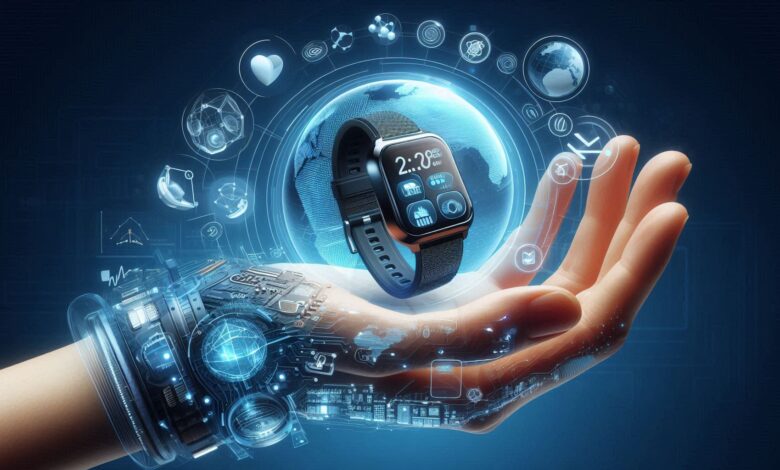The Future of Wearable Technology: Transforming Health, Fitness, and Daily Life in 2025

Wearable technology has come a long way from its humble beginnings. Once limited to basic fitness trackers, wearable technology now encompasses a wide range of devices that are reshaping how we live, work, and stay healthy. In 2025 and beyond, wearable tech is set to play an even bigger role in our daily lives, helping us monitor our health, enhance our fitness routines, and stay connected like never before.
This article explores the latest trends, innovations, and the many ways wearable technology is transforming our world. Whether you’re interested in improving your fitness, tracking your health metrics, or just staying connected, wearable technology offers a multitude of possibilities that will only continue to expand in the years to come.
What is Wearable Technology?
Wearable technology refers to any device that can be worn on the body, typically offering some form of tracking, monitoring, or communication capabilities. These devices are often designed to collect data, such as health metrics or movement patterns, and sync it with other digital platforms for analysis or use.
Examples of wearable technology include:
- Fitness trackers (e.g., Fitbit, Garmin)
- Smartwatches (e.g., Apple Watch, Samsung Galaxy Watch)
- Smart glasses (e.g., Google Glass, Vuzix)
- Wearable health monitors (e.g., continuous glucose monitors, smart clothing)
- Virtual reality headsets (e.g., Oculus Rift, HTC Vive)
These devices typically integrate with mobile apps and cloud services, allowing users to monitor various aspects of their health, productivity, and daily activities.
The Benefits of Wearable Technology
1. Health Monitoring and Disease Prevention
One of the biggest benefits of wearable technology is its ability to monitor and track health metrics in real time. Whether you’re tracking your heart rate, oxygen levels, sleep patterns, or even glucose levels, wearable devices can give you a comprehensive view of your health.
- Wearable health monitors like continuous glucose monitors (CGMs) and smartwatches with ECG (electrocardiogram) functionality allow users to monitor their vitals on the go, providing real-time alerts for any anomalies.
- Wearable ECGs can detect signs of heart conditions, alerting users before they experience any significant symptoms.
- Devices like the Oura ring and Whoop band monitor sleep patterns and recovery, offering insights into how well your body is recovering and helping optimize performance.
This kind of health monitoring can be vital for preventing serious health issues before they become life-threatening. Many people now rely on wearables for early detection of problems like arrhythmia, sleep apnea, or even signs of stress.
2. Fitness Tracking and Performance Optimization
For fitness enthusiasts, wearable technology offers an incredible advantage in tracking physical activity. Fitness trackers can monitor everything from step count and calories burned to more advanced metrics like VO2 max, heart rate variability, and muscle recovery.
- Smartwatches and fitness trackers like the Apple Watch, Fitbit, and Garmin can help users track workouts, set fitness goals, and measure progress over time.
- Many of these devices also offer real-time feedback, allowing users to adjust their activity level to maximize performance and reduce the risk of injury.
- Advanced trackers now measure muscle recovery, hydration levels, and even sleep cycles, giving athletes the data they need to perform at their best.
3. Increased Connectivity
Another significant advantage of wearable technology is its ability to keep you connected. Many wearables, particularly smartwatches, allow users to receive notifications, make calls, and interact with digital assistants without having to pull out their phones.
- Smartwatches like the Apple Watch or Samsung Galaxy Watch allow users to check texts, emails, and even social media notifications without needing to use a smartphone.
- Some smartwatches even offer the ability to make and receive calls, ensuring you stay connected even when you’re away from your phone.
- Wearable technology is also enhancing communication with the advent of smart glasses, such as Google Glass and Microsoft HoloLens, which enable hands-free interactions with digital content.
This constant connectivity is ideal for individuals who want to streamline their daily tasks and reduce distractions from their phones while maintaining access to important information.
4. Convenience and Hands-Free Operation
The convenience offered by wearable technology cannot be overstated. Smartwatches, for example, allow users to check the time, track their workouts, and receive notifications without having to take out their phones. This hands-free functionality provides a level of ease that traditional devices cannot match.
- Voice assistants integrated into smartwatches (e.g., Siri, Google Assistant, Bixby) enable users to complete tasks via voice commands, such as sending messages, setting reminders, or controlling smart home devices.
5. Enhanced User Experience with Augmented Reality (AR)
Wearable technology is pushing the boundaries of user experience with devices like augmented reality (AR) glasses and headsets. With AR capabilities, users can interact with digital content in new and exciting ways.
- Smart glasses such as Google Glass and Microsoft HoloLens are changing how users interact with the world, overlaying digital information onto the physical environment in real-time.
- These wearables are transforming industries like healthcare, education, and gaming by providing more immersive experiences and interactive content.
- Also Read: The Future of Smart Home Technology: Transforming Your Living Space in 2025

The Latest Trends in Wearable Technology
As wearable technology continues to evolve, the future promises even more exciting innovations. Below are some of the latest trends that will shape the future of wearables in 2025 and beyond:
1. Biometric Monitoring
The integration of biometric sensors into wearables is one of the most exciting developments in wearable tech. In the future, wearables may track more advanced metrics, such as blood pressure, glucose levels, and stress hormones, providing users with a comprehensive view of their health.
- Biometric sensors could help detect early signs of chronic diseases like diabetes, hypertension, and even mental health issues such as anxiety and depression.
2. AI-Powered Wearables
As artificial intelligence (AI) continues to advance, expect wearable technology to become smarter and more predictive. AI algorithms can analyze data from wearables to offer personalized recommendations for improving health, fitness, and even mental well-being.
- AI-powered wearables can detect patterns in a user’s behavior, predict health risks, and offer tailored suggestions for improving lifestyle habits.
3. Smarter Integration with IoT (Internet of Things)
The Internet of Things (IoT) is revolutionizing the connectivity between devices. As IoT devices become more widespread, wearables will become an even more integral part of the smart home ecosystem.
- Wearables will work seamlessly with other connected devices, such as smart thermostats, lights, and home security systems, enabling users to control their environment with ease.
4. Extended Battery Life
One of the major challenges of wearable technology has always been battery life. However, advancements in battery technology are paving the way for longer-lasting devices, allowing users to wear their tech for longer periods without needing to recharge.
- Wearable technology will continue to evolve with batteries that can last days or even weeks on a single charge, making it even more convenient for users to track their health and activities continuously.
How to Get Started with Wearable Technology
If you’re interested in adopting wearable technology in your life, here’s a simple guide to get started:
1. Identify Your Needs
Start by understanding what you want from your wearable device. Are you interested in fitness tracking, health monitoring, or staying connected with your smartphone? This will help guide your choice of device.
2. Choose the Right Device
Choose a wearable that fits your needs and lifestyle. For fitness enthusiasts, a fitness tracker or smartwatch with health features may be ideal. If you’re more interested in hands-free convenience, a pair of smart glasses or a smartwatch with voice assistant integration might be a better choice.
3. Sync with Other Devices
Many wearables work best when connected with other devices, such as smartphones or smart home systems. Make sure your wearable is compatible with the devices and apps you plan to use.
4. Monitor Your Progress
Once you’ve set up your wearable, start tracking your progress and data. Many wearables offer analytics and insights to help you improve your health, fitness, or productivity.
Conclusion: Embracing the Future of Wearable Technology
Wearable technology is transforming the way we live, work, and stay healthy. From fitness trackers that monitor your steps and heart rate to smartwatches that keep you connected throughout the day, wearables are revolutionizing daily life.
As the technology continues to advance, we can expect even more innovative features and applications in the coming years. By adopting wearable technology, you can take control of your health, enhance your fitness routines, and stay connected like never before.





One Comment